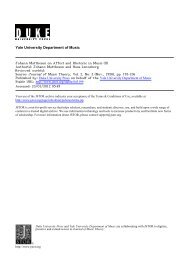Après une Lecture de Liszt: Virtuosity and ... - Free
Après une Lecture de Liszt: Virtuosity and ... - Free
Après une Lecture de Liszt: Virtuosity and ... - Free
Create successful ePaper yourself
Turn your PDF publications into a flip-book with our unique Google optimized e-Paper software.
19THCENTURYMUSICtechniques (<strong>and</strong> in<strong>de</strong>ed they often have been).For example, whereas Beethoven’s variationform at the end of op. 77 is <strong>de</strong>fined by a generic“style,” <strong>Liszt</strong>’s thematic transformations arenot limited to any particular style (as is evi<strong>de</strong>ntfrom <strong>Liszt</strong>’s <strong>and</strong> Czerny’s use of the procedurein their different musical languages). Furthermore,variation form was a musical genre aswell as a mo<strong>de</strong> of invention. Thematic transformationwas not; it could be a generativeprocess within a variety of forms, includingvariation form, but it belonged to no genre outsi<strong>de</strong>of its improvisatory heritage.Nonetheless, the boundaries between thesemusical procedures can become mobile. AsBeethoven himself observed in a sketch from1809, “Real fantasy-like improvisation[Phantasieren] comes only when we are unconcerned[with] what we play, so—if we want toimprovise in the best, truest manner in public—weshould give ourselves over freely towhat comes to mind.” 86 The correspon<strong>de</strong>nce toCzerny’s advice to “give free reign to [one’s]flights of fancy” 87 is unmistakable. Beethoven’scomment further presages <strong>Liszt</strong>’s belief in theprimacy of “feeling <strong>and</strong> invention” in the creativeprocess. In view of this shared belief, wemay say that in op. 27 Beethoven had writtentwo sonatas, parts of whose form gave the impressionof an improvisation, while in his“Dante” Sonata, <strong>Liszt</strong> improvised—at least initheprincipal theme, a “normal first section,”are reprised in diminution. The section is theninterrupted by a fantasy-like passage (thoughone that does not retain the original motive),after which the main section returns with thetreble <strong>and</strong> bass parts reversed. The Sonata alsoallu<strong>de</strong>s to its slow movement just before thecoda of its finale, a more obviously <strong>Liszt</strong>-likeprocedure.Czerny’s second category—“free variation”—is also relevant to <strong>Liszt</strong> because of the similaritybetween this subgenre of classical variationform <strong>and</strong> the principle of thematic transformation.In his discussion of monothematic improvisation,Czerny likened his own musical examples(ex. 2) to the procedure in Beethoven’sChoral Fantasy, op. 80 (containing fifteen variations),where the piano introduction is probablybased on Beethoven’s own extempore performanceat the premiere on 22 December 1808,<strong>and</strong> in the choral finale of the Ninth Symphony,op. 125 (1824). The two works, Czernyadds, form “two glorious monuments of thisstyle [of Phantasieren].” 84Finally, the great textural <strong>and</strong> melodic varietyin the “mixed form” of op. 77 (containingseven stable variations) would seem to justifyCzerny’s observation that, in Phantasieren,Beethoven “trusted to his genius for the constantinvention of new subjects.” 85 If this <strong>and</strong>the other two works cited by Czerny do in<strong>de</strong>edreflect Beethoven’s style of improvisation on atheme, they offer an analytical basis for comparingBeethoven’s approach to Phantasierenwith that of <strong>Liszt</strong>. Pace Czerny, however, theart of thematic improvisation that his treatisedocuments is qualitatively different from thetechnique of theme <strong>and</strong> variation evi<strong>de</strong>nt inBeethoven’s “Fantasy” works. It is of coursepossible that these later works fail to documentthe thematic transformations that characterizedBeethoven’s actual improvisations(<strong>and</strong> such transformations do occasionally surfacein his other works), but this kind of hypothesismust remain speculative. The transformation<strong>and</strong> the variation of a theme cantherefore be teased apart as separate musical84Michell, A Systematic Introduction, p. 52.85Czerny, On the Proper Performance, p. 58.86This is scribbled on a musical sketch from 1809. I takethis reference from Lewis Lockwood, whose chapter“Beethoven at the Keyboard” explores Beethoven’s extemporepractices. Reports about Beethoven’s improvisationfrequently emphasize the freedom of his musical creativity,<strong>and</strong> while such reports are hardly more than subjectivereinterpretations of an event, their consistent emphasisseems to indicate that established formal structureshad little bearing on Beethoven’s mixed form Phantasieren.For example, Sir John Russell witnessed an improvisationin 1821 wherein Beethoven “gradually . . . forgot everythingelse, <strong>and</strong> ran on during half an hour in a fantasy, in astyle extremely varied, <strong>and</strong> marked, above all, by the mostabrupt transitions” (Beethoven: Impressions by His Contemporaries,ed. O. G. Sonneck [New York: Schirmer, 1926],pp. 115–16; see also pp. 13, 22, 51–52, 208–09). Other contemporaryaccounts of Beethoven’s improvisations inclu<strong>de</strong>Czerny, On the Proper Performance of All Beethoven’sWorks for the Piano, ed. Paul Badura-Skoda (Vienna: Universal,1970); <strong>and</strong> J. G. Prod’homme, “The Baron <strong>de</strong>Trémont: Souvenirs of Beethoven <strong>and</strong> Other Contemporaries,”Musical Quarterly 6 (1920), 366–91.87Michell, A Systematic Introduction, p. 74.76



